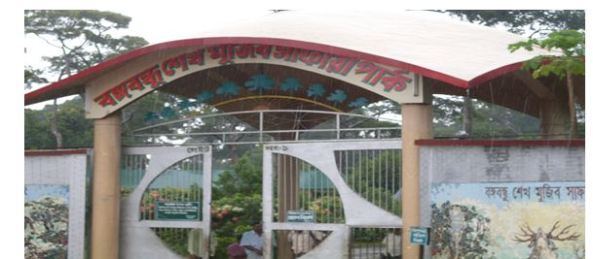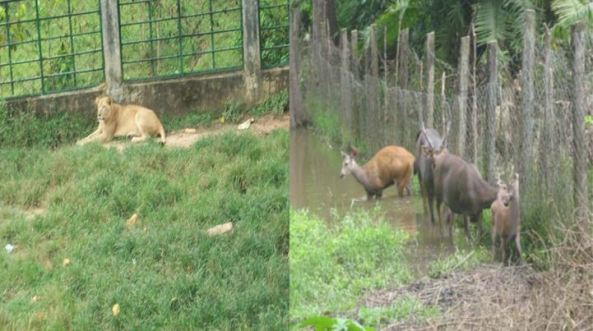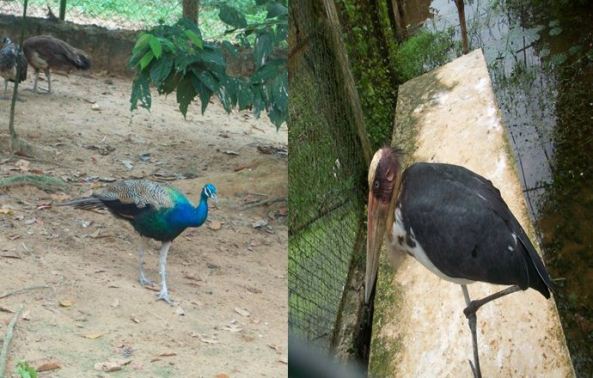a. Introduction:
A large enclosed area of land declared by the Government where wild animals wander relatively freely and people pay to drive around by car or vehicle or by walking and observe them for recreation, education and research, is called safari park. This is also called wild-park. Dulhazra or Bangabandhu Safari park is the only one safari park in Bangladesh. It is so important and attractive because of its natural biodiversity specially wildlife.
b. Location & Area:
Banghabandhu Safari park is situated about 107 Km south from Chittagong town by the east side of Cox’s Bazaar, Chittagong high way road and 5Km south from Chokoria sadar upazilla. The distance between BSF and Cox’s Bazaar is 40 Km and the total area of BSF is about 900 ha.
c. Safari park:
Safari park is a government permitted ecologically critical area (ECA). It has the facilities of endogenous and foreign wild animal breeding and free living. Safari park is far different from zoo. Tourists and researchers can travel by transport or on foot carefully for education, research and recreational purposes.
d. Faunal composition of Banghabandhu Safari Park:
A. Mammals:
Figure: Tiger and Deer
Local name Scientific name
1. Tiger Panthera tigris
2. Lion Panthera leo
3. Leopord Panthera pardus
4. Maya deer Muntiacus muntjak
5. Elephant Elephas maximus
6. Hog deer Axis procinus
7. Hanuman Seminopithecus entellus
8. Binturong bear cat Artistis binturong
9. Wild pig Sus scruffy
10. Rufustailled hare Lepus negricolis
11. Goyal Bos gaurus
12. Wild cat Felis chaus
13. Ud cat Lutra lutra
14. Shajaru Hystrix indica
15. Flying fox Petropus goganteus
16. Fols vampair Megaderma lyra
17. Clouded leopord Neofeles nebulosa
18. Rhesus monkey Macaca mulatta
19. Lazzabati monkey Nycticebus coucang
20. Assami monkey Macaca assamensis
21. Asiatic black beer Selenorctos thibetanus
22. Samber deer Cervus uncoiled
23. Fox Canis aureus
24. Spring bok Antidorcas marsupialis
25. Espalla epyceros melampus
B. Birds:
Figure: Pecock and Madantak
Local name Scientific name
1. Pankouri Phalacrocoras niger
2. Mothura Loophura leucomelana
3. Black headed muina Sturns pagodarum
4. Parrot Psittacula krameri
5. Tuntuni Orthotomus sutorius
6. Love bird Agapornis fischeri
7. Munia Munia
8. Black fingers Dicrurus remifer
9. Wild cock Gallus gallus
10. Choruy Passer domesticus
11. Petcock Pavo cristatus
12. Crane Grus grus
13. White pelican Pelicanus anocrotalus
14. Tarkish pheasant Tarkish pheasant
15. White dove Streptopelia diaconate
16. Pantha mukhi Anas clypeata
17. Kakatua Cacatua gallerias
18. Small kingfisher Alcedo atthis
19. Black headed kingfisher Halcyon pileata
C. Reptiles:
Local name Scientific name
1. Fresh water crocodile Crocodilus palustrus
2. Salt water crocodile Crocodilus porosus
3. Python Python molurus
4. Sim tortoise Chitra indica
5. Bostami tortoise Aspideretes nigricans
6. Star tortoise Star tortoise
e. Floral composition of Banghabandhu Safari Park:
A. Tall trees:
Local name Scientific name
1. Kali garjan Diptocarpus turbinatus
2. Shimul Bombax ceiba
3. Bot Ficus bengalansis
4. Chapalish Artocarpus chaplasha
5. Shil Koroi Albizia procera
B. Medium & small trees:
Local name Scientific name
1. Dumur Ficus semicordata
2. Sonalu Cassia fistula
3. Chalta Dillenia indica
4. Ashok Saraca indica
5. Mehogony Swietnia mahagon
C. Shrubby plants:
Local name Scientific name
1. Assam lata Eupatorium odoratum
2. Nal khagra Saccharum spontaneum
3. Jungli banana Musa sapientum
4. Kanchon Bauhinia acuminate
f. Others in Banghabandhu Safari Park:
Display map:
There was a display map of safari park at the left side of the main gate which the tourist and give a through idea of the safari park and it’s splendid places.
Orchid house:
There was orchid house beside the display map.
Sea view observation tower:
Observation tower is made for observing tiger lion and different wild animal.
Lake:
There were 8 water reservoirs and two lakes were made in 50 hectare area for the source of water of plant and animal.
Elephant riding:
Elephant enclosure was made in 150 hectare area of north-east side of the park. Tourists enjoy by riding and observing the elephant.
Visit to tiger and lion enclosure:
Tiger and lion enclosure is made by 70 hectare forest area of the park.
Nature interpretation centre:
The first national interpretation centre of Bangladesh is situated at the side of BSP information centre.
National history museum:
There was a history museum which contains 2000 animal residues, specimens, stuffing and300 species herbarium seeds of plants. The Dulahazara natural history museum is one of the great collections of wild life. There are many birds and wild animals such as Spotted Deer, Monkey, Bongai, Elephant, Bear, Buffalo, Wild Cock, Python, Peacock, Vulture, Danish bird and Harikal bird are now available in Dulahazara Safari park. There are many marine chordate and non-chordate animals in the sea beach region. It helps to the tourist, students and researchers to have a clear concept about endemic wild animals.
Audio visual display:
There was a audio visual display centre where tourist can enjoy a 25 minutes length audio visual program which helped them a lot to get a vast idea about the park.
Architectural structure:
There were some structure of wild animal such as pea-cocks, snakes, dinosaur, and attractive wood made pool presented in different places of safari park.
Bird house:
A bird house was present on the way where various types of birds were shown.
Crocodile enclosure:
More than 30 marsh crocodile were present in crocodile enclosure and some marine crocodile were present at the side of the marsh crocodile under boundary.
Aquatic bird breeding centre:
Brahma kite, lesser coucal, Great hornbill, Oriental pied hornbill were present in aquatic bird breeding centre. We also saw a well decorated reception gate, main gate, deer breeding centre, vegetarian animal enclosure, deer enclosure, hippopotamus enclosure, somber deer enclosure, hog deer enclosure, bear enclosure, security post, water tank and pump.
g. Conclusion:
Banghabandhu safari park includes a wide variety of wild animals living in a quasi national environment. This park plays an important role to protect extinction of various animals which are very essential for our nature. This park allows visitors to see them freely. Visitors can enrich their knowledge by visiting this park.



